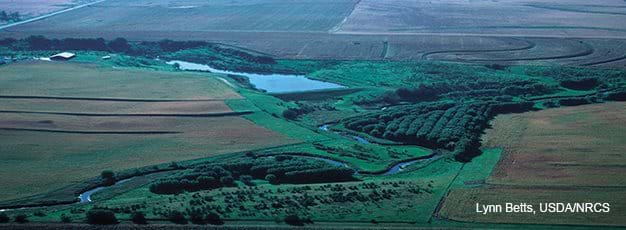Targeting Conservation Funds Increases Environmental Benefits

USDA conservation program funding has increased steadily from $0.5 billion in 1985 to $5.1 billion in 2005. Because of agriculture’s close connection with the environment, conservation programs can provide many environmental gains. To best serve the public’s interest, program funds could be allocated to address the most pressing environmental concerns. Targeting is an efficient means of achieving this goal because it directs funds to conservation program participants based on the expected environmental benefits.
Conservation programs can be targeted in many ways, ranging from simple to highly selective. Targeting can direct funds to:
- A region, such as the Chesapeake Bay watershed. This simple “broad brush” approach is generally not the most efficient way to target but can be effective when data are limited or the region is a particularly sensitive environmental area.
- Acreage with particular features, such as highly erodible lands. This focus is more selective and likely more efficient than regional targeting because it accounts for intra-regional variations in factors that affect environmental concerns.
- Fields and farms that provide the greatest environmental benefits. This highly selective approach accounts for at least some of the field- and farm-level variations in benefits.
Targeting becomes more efficient as it accounts for more variations in environmental concerns. Benefits vary because the same conservation measure can have different environmental impacts, even on neighboring fields. For example, the water quality impacts of a conservation practice will depend on the field’s proximity to water. Moreover, the same water quality benefits may be valued more highly near popular vacation areas than in less visited areas.
Addressing multiple environmental concerns also improves targeting efficiency. For example, the Conservation Reserve Program (CRP) initially targeted highly erodible lands only. The CRP now targets based on an Environmental Benefits Index (EBI), which quantifies multiple environmental benefits, including wildlife habitat and air and water quality. By moving from its initial targeting mechanism to the use of the EBI, the CRP benefits associated with freshwater recreation, wildlife viewing, and pheasant hunting increased from an estimated $460 million to almost $830 million per year for the same level of spending.
In general, program benefits will increase as targeting becomes more selective, which will require more data and a better understanding of the effects of conservation practices. As additional geospatial data—including satellite imagery data—become available and the links between conservation practices and benefits are more understood, environmental targeting mechanisms can be further improved and environmental gains from conservation programs can increase.
Better Targeting, Better Outcomes, by LeRoy Hansen and Daniel Hellerstein, USDA, Economic Research Service, March 2006
The Conservation Reserve Program: Economic Implications for Rural America, by Shawn Bucholtz, Patrick Sullivan, Daniel Hellerstein, LeRoy Hansen, Robert Johansson, Steven Koenig, Ruben N. Lubowski, William D. McBride, David McGranahan, Stephen Vogel, and Michael Roberts, USDA, Economic Research Service, October 2004


